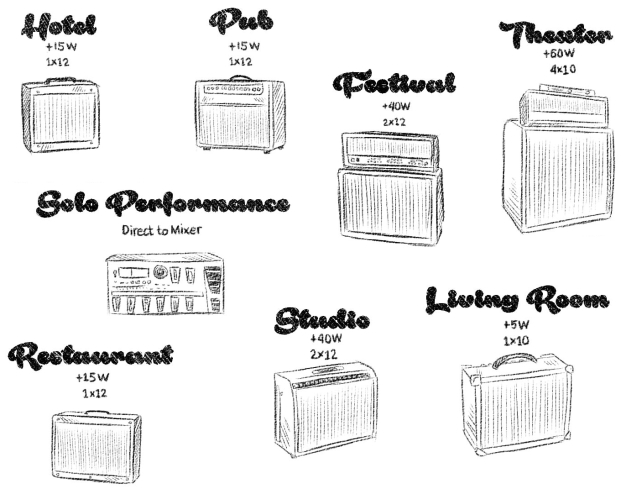
When it comes to choosing an amplifier, size is usually the first thing you need to consider before making your purchase. Although a wall of amps is every guitar players fantasy, size is quickly becoming less of a determining factor for good tone as technology gets better. In early years there were no PA systems to boost the sound of an amp. This meant that the amplification on stage had to project all the way to the back of the room. With modern PA systems, this is no longer the case. Thankfully so – as nobody wants ringing or damaged ears after the gig.
For gigging purposes, you’re going to need an amp that’s loud enough to hear yourself on stage. This is the only factor you need to concern yourself with, as your amp will be mic’d up and running through a PA system. Your amp is used as your personal stage monitor and therefore doesn’t need to be very powerful. I’ve played in situations where the PA system has done a lot of the sound of my amp. Depending on the PA system configuration and the expertise of the front of house audio engineer, you may find yourself with a massive sound coming from a tiny amp.
Before selecting the right amp size for your needs, you first need to consider what type of amplifier you’re going to require:
- Valve – These amps are popular amongst guitar players because of their rich harmonic content. They produce a warmth that is very pleasing to the human ear. For the purpose of this article, we will only be focussing on valve amps.
- Hybrid – A combination of solid state and valve technology. These amps are less expensive than full-on valve amps.
- Solid State – These amps are very affordable and much lighter than a valve-based amp, although they are known to sound “harsh” and don’t perform well in gigging scenarios.
- Modulation – See: Using Amp Simulation Live On Stage.
When it comes to the amount of watts, my recommendation is that you pay little attention to this value. Wattage is a poor measurement for determining loudness. Keep in mind that you need double the wattage to see an increase of 3dB in volume. Therefore a 100W tube amp is only 3dB louder than a 50W amp. To hear yourself above the drummer you’re going to need 5 watts or more. I would look into a higher wattage (60W+) ONLY if you’re playing in situations without a PA system.
This brings me to the final determining factor for amp size: portability. Now we know that we don’t need powerful amplification for the gig, so we can focus primarily on choosing something that’s easy to transport. Trust me on this one. Carrying heavy gear can quickly deter you from wanting to play live. I’ve found that 2×12 combo amps are often too heavy and impractical for certain gig venues due to their excessive weight. The best amps to use for pub and club gigs are 1×12 configurations, or an easy to transport head and cab.
Here are some guidelines for choosing the best amp size for the venue you’re playing:
- Hotel – 1×12 (15W)
- Pub/Club/Bar – 1×12 (15W)
- Festival – 2×12 (40W)
- Theatre – 4×10 (60W)
- Solo Performance – Direct to Mixer Effects Unit
- Restaurant – 1×12 (15W)
- Studio – 2×12 (60W)
- Living Room – 1×10 (5W)
